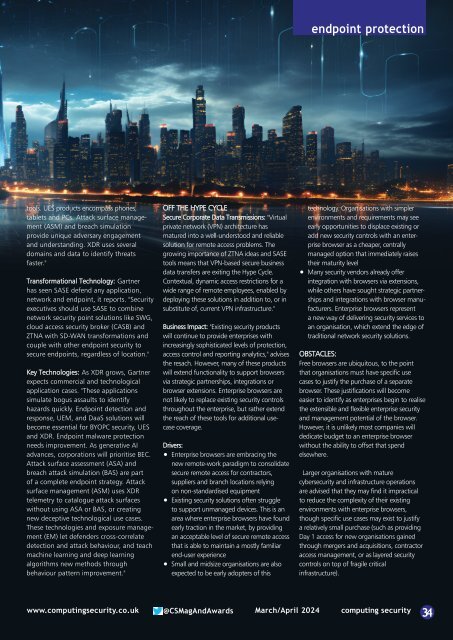CS Mar-Apr 2024
Create successful ePaper yourself
Turn your PDF publications into a flip-book with our unique Google optimized e-Paper software.
endpoint protection<br />
tools. UES products encompass phones,<br />
tablets and PCs. Attack surface management<br />
(ASM) and breach simulation<br />
provide unique adversary engagement<br />
and understanding. XDR uses several<br />
domains and data to identify threats<br />
faster."<br />
Transformational Technology: Gartner<br />
has seen SASE defend any application,<br />
network and endpoint, it reports. "Security<br />
executives should use SASE to combine<br />
network security point solutions like SWG,<br />
cloud access security broker (CASB) and<br />
ZTNA with SD-WAN transformations and<br />
couple with other endpoint security to<br />
secure endpoints, regardless of location."<br />
Key Technologies: As XDR grows, Gartner<br />
expects commercial and technological<br />
application cases. "These applications<br />
simulate bogus assaults to identify<br />
hazards quickly. Endpoint detection and<br />
response, UEM, and DaaS solutions will<br />
become essential for BYOPC security, UES<br />
and XDR. Endpoint malware protection<br />
needs improvement. As generative AI<br />
advances, corporations will prioritise BEC.<br />
Attack surface assessment (ASA) and<br />
breach attack simulation (BAS) are part<br />
of a complete endpoint strategy. Attack<br />
surface management (ASM) uses XDR<br />
telemetry to catalogue attack surfaces<br />
without using ASA or BAS, or creating<br />
new deceptive technological use cases.<br />
These technologies and exposure management<br />
(EM) let defenders cross-correlate<br />
detection and attack behaviour, and teach<br />
machine learning and deep learning<br />
algorithms new methods through<br />
behaviour pattern improvement."<br />
OFF THE HYPE CYCLE<br />
Secure Corporate Data Transmissions: "Virtual<br />
private network (VPN) architecture has<br />
matured into a well-understood and reliable<br />
solution for remote access problems. The<br />
growing importance of ZTNA ideas and SASE<br />
tools means that VPN-based secure business<br />
data transfers are exiting the Hype Cycle.<br />
Contextual, dynamic access restrictions for a<br />
wide range of remote employees, enabled by<br />
deploying these solutions in addition to, or in<br />
substitute of, current VPN infrastructure."<br />
Business Impact: "Existing security products<br />
will continue to provide enterprises with<br />
increasingly sophisticated levels of protection,<br />
access control and reporting analytics," advises<br />
the resach. However, many of these products<br />
will extend functionality to support browsers<br />
via strategic partnerships, integrations or<br />
browser extensions. Enterprise browsers are<br />
not likely to replace existing security controls<br />
throughout the enterprise, but rather extend<br />
the reach of these tools for additional usecase<br />
coverage.<br />
Drivers:<br />
Enterprise browsers are embracing the<br />
new remote-work paradigm to consolidate<br />
secure remote access for contractors,<br />
suppliers and branch locations relying<br />
on non-standardised equipment<br />
Existing security solutions often struggle<br />
to support unmanaged devices. This is an<br />
area where enterprise browsers have found<br />
early traction in the market, by providing<br />
an acceptable level of secure remote access<br />
that is able to maintain a mostly familiar<br />
end-user experience<br />
Small and midsize organisations are also<br />
expected to be early adopters of this<br />
technology. Organisations with simpler<br />
environments and requirements may see<br />
early opportunities to displace existing or<br />
add new security controls with an enterprise<br />
browser as a cheaper, centrally<br />
managed option that immediately raises<br />
their maturity level<br />
Many security vendors already offer<br />
integration with browsers via extensions,<br />
while others have sought strategic partnerships<br />
and integrations with browser manufacturers.<br />
Enterprise browsers represent<br />
a new way of delivering security services to<br />
an organisation, which extend the edge of<br />
traditional network security solutions.<br />
OBSTACLES:<br />
Free browsers are ubiquitous, to the point<br />
that organisations must have specific use<br />
cases to justify the purchase of a separate<br />
browser. These justifications will become<br />
easier to identify as enterprises begin to realise<br />
the extensible and flexible enterprise security<br />
and management potential of the browser.<br />
However, it is unlikely most companies will<br />
dedicate budget to an enterprise browser<br />
without the ability to offset that spend<br />
elsewhere.<br />
Larger organisations with mature<br />
cybersecurity and infrastructure operations<br />
are advised that they may find it impractical<br />
to reduce the complexity of their existing<br />
environments with enterprise browsers,<br />
though specific use cases may exist to justify<br />
a relatively small purchase (such as providing<br />
Day 1 access for new organisations gained<br />
through mergers and acquisitions, contractor<br />
access management, or as layered security<br />
controls on top of fragile critical<br />
infrastructure).<br />
www.computingsecurity.co.uk @<strong>CS</strong>MagAndAwards <strong>Mar</strong>ch/<strong>Apr</strong>il <strong>2024</strong> computing security<br />
34
















